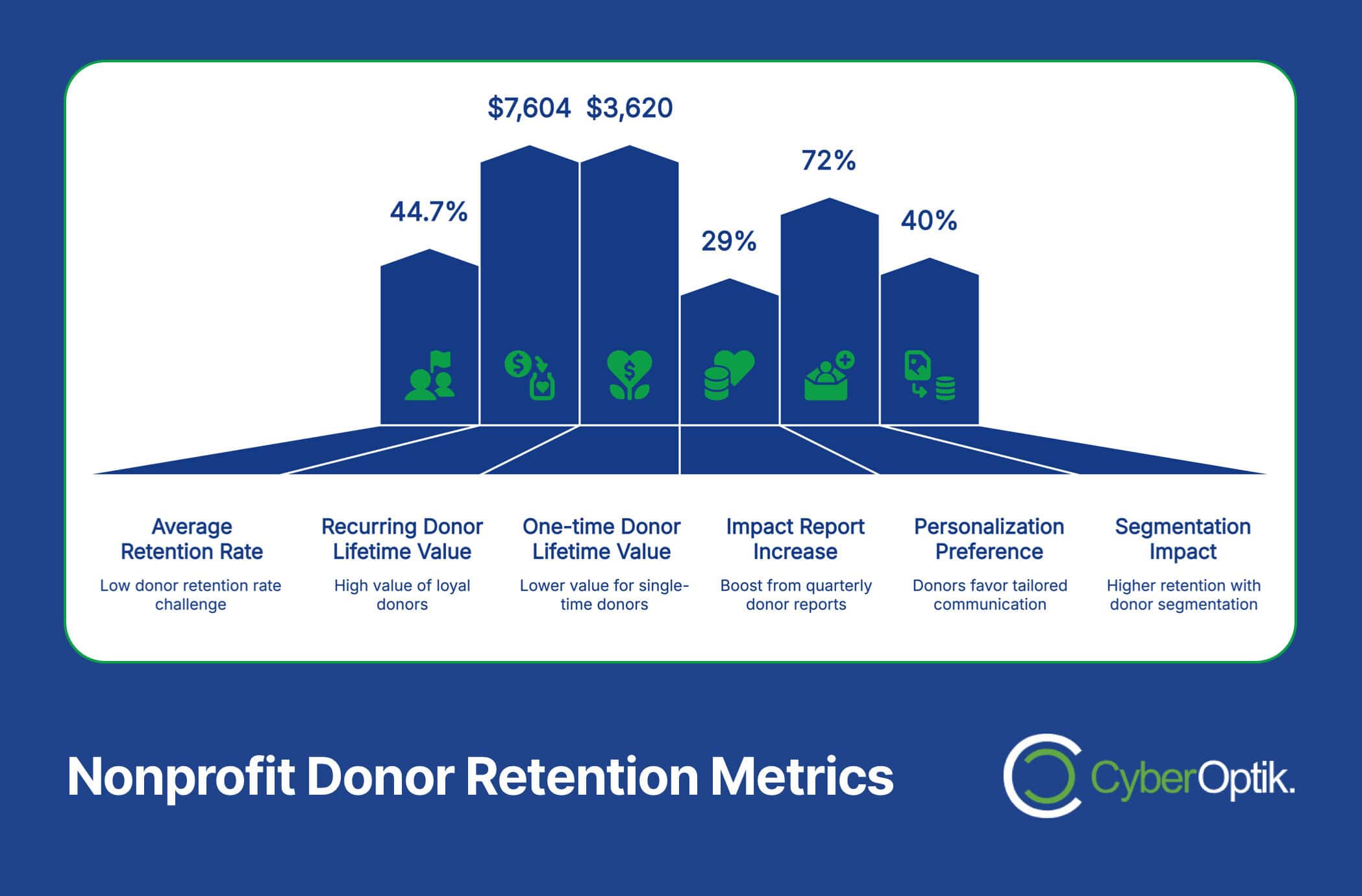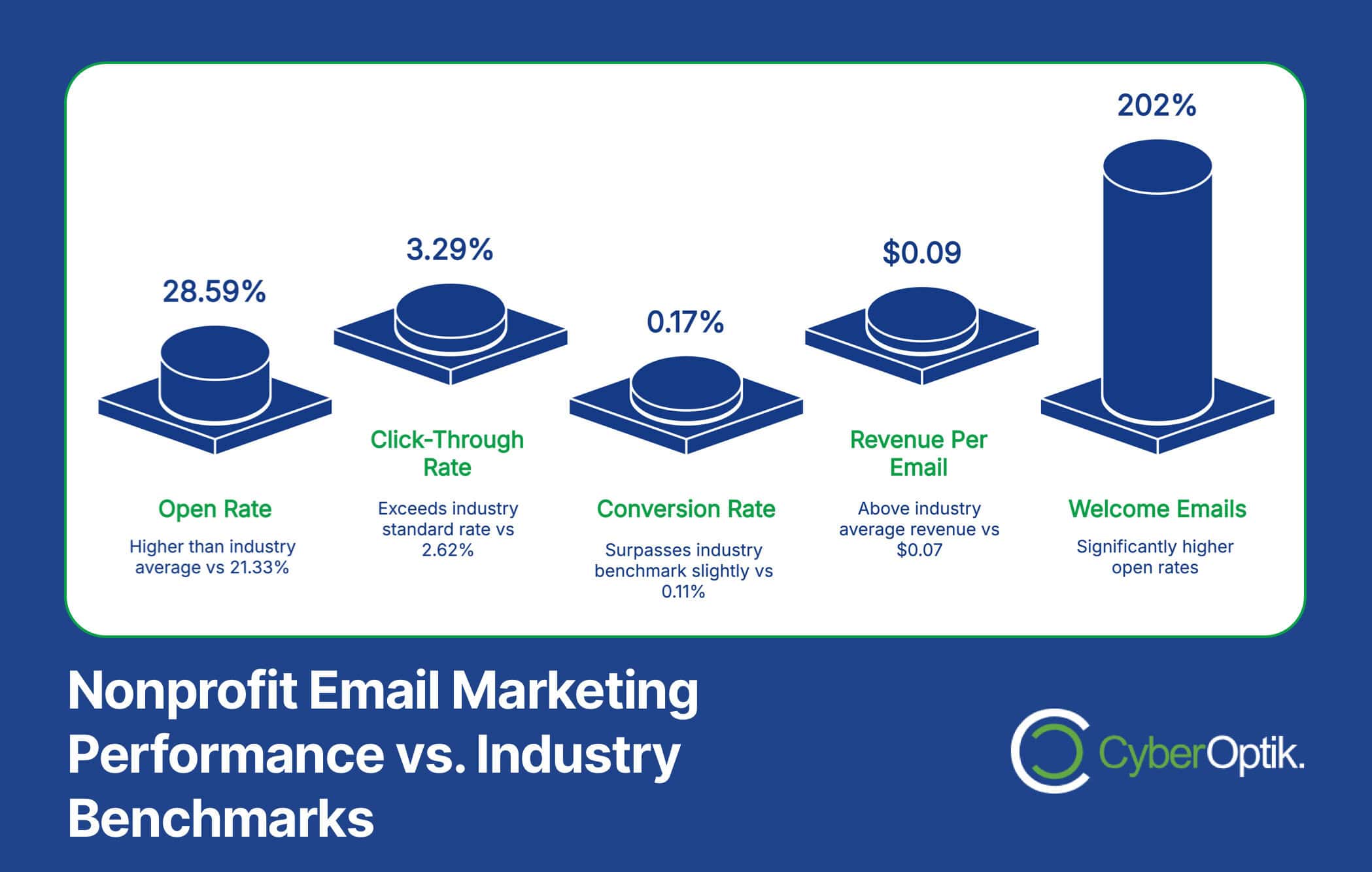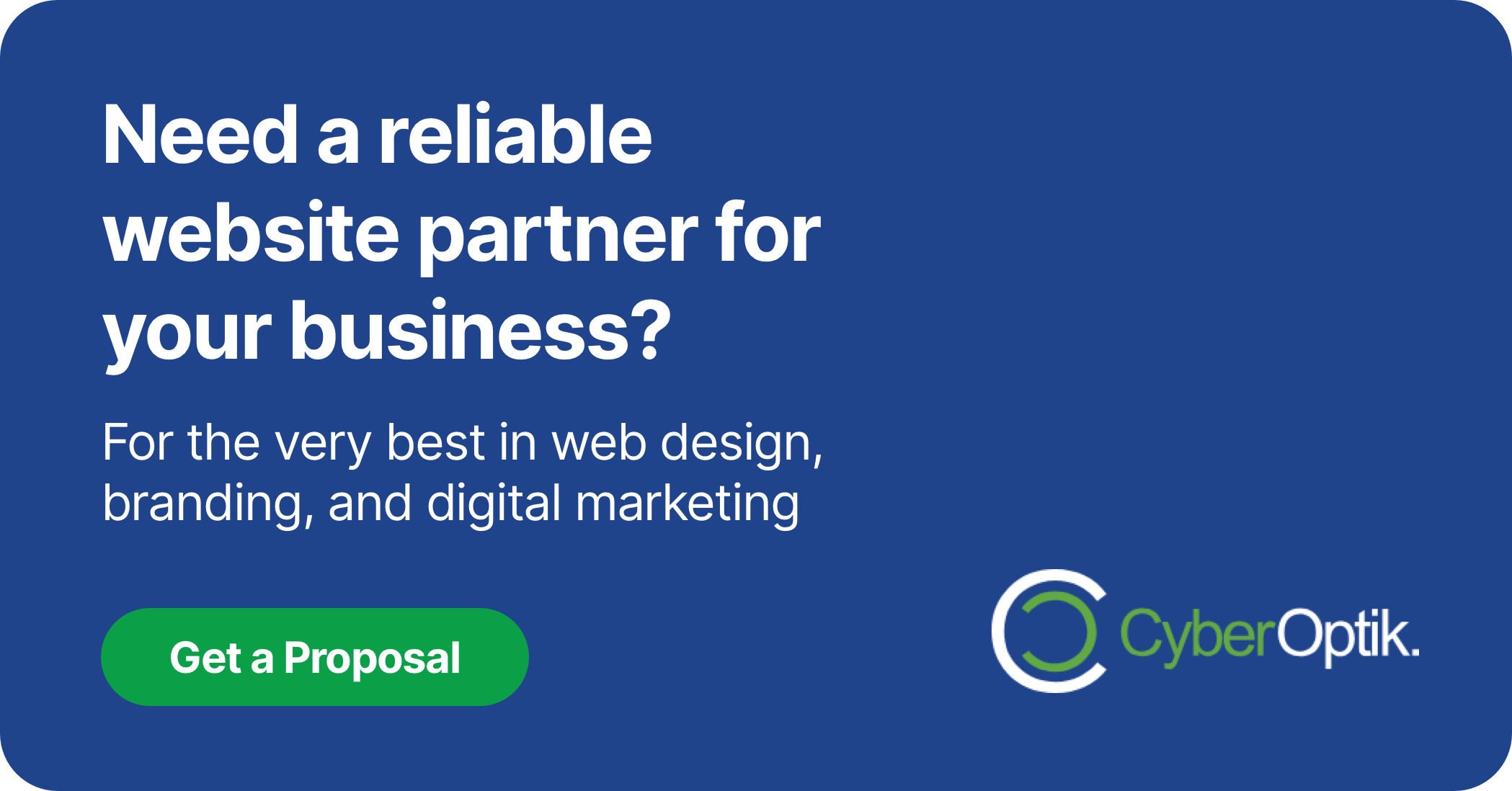Nonprofit marketing faces unique challenges. Organizations must engage donors, recruit volunteers, and promote their mission with limited resources. Success requires strategic approaches tailored specifically to nonprofit needs.

Effective nonprofit marketing makes a real difference. It helps connect with supporters and drives sustainable funding. Strategic marketing also builds community awareness and strengthens volunteer programs over time.
As a web design and digital marketing agency, we understand what makes nonprofit communications work. We’ve seen firsthand how the right strategies transform outreach efforts. This guide shares proven approaches to boost your nonprofit’s marketing impact.
The following strategies focus on practical tactics you can implement now. Each approach is backed by research and designed for organizations of any size. Let’s explore what works best for nonprofit marketing in today’s digital landscape.
Donor Engagement Strategies That Drive Results
Donor retention requires focused attention. Nonprofits average just a 44.7% donor retention rate, meaning over half of supporters don’t return to give again. (Source: Double the Donation)
Successful donor relationships follow a clear pattern. They begin with effective onboarding and continue through regular, meaningful communications. Consistent engagement keeps supporters connected to your mission over time.
Let’s examine the most effective approaches to donor engagement.
New Donor Nurturing Programs
First-time donors need special attention. A structured nurturing program converts one-time givers into recurring supporters. These programs significantly impact retention when implemented properly.
What makes a donor nurturing program effective? Research shows successful programs follow a specific structure with multiple touch points. Below are the essential components every program should include:
- Immediate acknowledgment – Send personalized thank-you messages within 48 hours
- Impact storytelling – Share specific examples of how donations help beneficiaries
- Educational content – Provide deeper insights into your nonprofit’s work and mission
- Second gift invitation – Request another contribution with clear impact statements
- Engagement opportunities – Offer non-monetary ways to participate in your community
Organizations implementing structured 3-step nurturing programs see significant improvements in donor retention. These sequences typically include immediate acknowledgment, impact reporting, and personalized follow-up. (Source: Getting Attention)
Impact-Focused Communications
Donors respond to clear impact stories. Most supporters want to know exactly how their contributions make a difference. Effective impact communications transform giving from a transaction into a meaningful experience.
Personalization plays a crucial role in donor communications. Research indicates that 72% of donors prefer receiving personalized messages that speak directly to their interests and past support history. (Source: Campaign Monitor)
Regular impact reporting drives measurable results. Organizations sending quarterly impact reports experience a 29% increase in recurring donations compared to those communicating less frequently. These reports work best when they include specific outcomes and personal stories. (Source: NP Tech for Good)
Let’s look at how different types of impact communications perform with donors:
| Communication Type | Donor Preference | Engagement Rate | Best For |
|---|---|---|---|
| Personal Stories | Very High | 40-45% | Emotional Connection |
| Statistical Impact | Moderate | 25-30% | Analytical Donors |
| Behind-the-Scenes | High | 35-40% | Building Trust |
| Beneficiary Testimonials | Very High | 45-50% | Demonstrating Outcomes |
This comparison helps identify which communication styles resonate most with different donor segments. Beneficiary testimonials consistently show the highest engagement rates across most nonprofit audiences.
Multi-Channel Outreach Approaches
Donors engage through multiple channels. Today’s supporters expect to interact with organizations across various platforms. A multi-channel strategy ensures you reach people where they already spend time.
Email and social media drive significant donor activity. Research shows that email inspires 26% of online donations, while social media drives 25% of giving actions. This highlights the importance of maintaining strong presences on both channels. (Source: WPBeginner)
Search advertising offers exceptional returns for nonprofits. Organizations using Google Ad Grants report earning $3.72 for every $1 spent on search campaigns when implemented strategically. This makes search one of the highest-ROI channels available. (Source: Feathr)
Creative fundraising channels continue to emerge. Many organizations now leverage NFT fundraisers and peer-to-peer campaigns, which achieve 47% conversion rates when executed properly. These approaches particularly appeal to younger donors. (Source: Council of Nonprofits)
Volunteer Recruitment and Retention Tactics
Volunteers contribute far beyond their time. Organizations often overlook how volunteer engagement influences overall fundraising success. Smart volunteer programs recognize this connection and leverage it strategically.
The volunteer-donor connection offers significant value. Research demonstrates that 85% of volunteers also donate to the organizations where they volunteer. This makes volunteer recruitment a dual-purpose activity that boosts both operational capacity and fundraising. (Source: Blackbaud)
Personal outreach drives volunteer recruitment best. In-person volunteer requests prove 34 times more effective than email solicitations alone. This highlights the importance of face-to-face conversations when building volunteer teams. (Source: ACC)
Converting Volunteers to Donors
Volunteer experiences shape giving decisions. People who volunteer regularly gain firsthand knowledge of your mission’s impact. This direct experience creates emotional connections that often lead to financial support.
Strategic volunteer communications build donor pipelines. Showing volunteers their impact and connecting it to broader funding needs creates natural giving opportunities. Successful programs integrate these messages throughout the volunteer journey.
Below are the most effective volunteer engagement tactics that support both retention and giving:
- Recognition programs – Celebrate volunteer contributions through formal acknowledgment
- Skills-based matching – Align volunteer roles with professional expertise
- Impact reporting – Share how volunteer efforts advance your mission
- Social opportunities – Create community-building events for volunteer teams
- Leadership pathways – Offer growth opportunities for dedicated volunteers
These strategies help build strong volunteer communities while establishing natural pathways to financial support. Organizations implementing comprehensive volunteer engagement programs typically see higher overall giving rates.
Email Marketing for Nonprofits

Email remains highly effective for nonprofits. Despite numerous digital channels available today, email continues delivering exceptional results for fundraising and communication. Strategic email programs drive measurable outcomes.
Nonprofit email performance exceeds many industries. Organizations achieve average open rates of 28.59% and click-through rates of 3.29% when following best practices. These metrics surpass many commercial sector benchmarks. (Source: NP Tech for Good)
Let’s explore the key metrics and strategies that drive successful nonprofit email programs:
| Email Metric | Nonprofit Average | Industry Benchmark | Top Performers |
|---|---|---|---|
| Open Rate | 28.59% | 21.33% | 35%+ |
| Click-Through Rate | 3.29% | 2.62% | 5%+ |
| Conversion Rate | 0.17% | 0.11% | 0.25%+ |
| Revenue Per Email | $0.09 | $0.07 | $0.15+ |
These benchmarks help organizations measure their email program performance against sector standards. Top-performing nonprofits consistently achieve metrics in the right column through strategic optimization.
Optimizing Email Performance
Email optimization starts with fundamentals. Subject lines, sender names, and send times significantly impact open rates. Content quality and call-to-action clarity determine click-through performance once emails are opened.
Revenue potential from email remains substantial. Well-designed email campaigns generate approximately $90 for every 1,000 emails sent. This makes email one of the most cost-effective channels for fundraising communications. (Source: WPBeginner)
Here are the most effective practices for nonprofit email marketing:
- Compelling subject lines – Use action verbs and create curiosity
- Mobile optimization – Ensure all emails display properly on smartphones
- Clear call-to-action – Include a single, prominent action request
- Personalization – Address recipients by name and reference past interactions
- Segmentation – Send targeted content based on donor behavior and interests
These best practices help maximize email engagement and conversion rates. Testing different approaches helps refine what works best for your specific audience segments.
Automated Email Sequences
Automated emails deliver exceptional results. Welcome sequences, donation follow-ups, and re-engagement campaigns work continuously without requiring manual sending. These automated journeys nurture relationships automatically.
Welcome emails significantly outperform standard messages. Automated welcome emails achieve 202% higher open rates than typical nonprofit emails. This makes the welcome sequence a critical opportunity to establish strong connections with new subscribers. (Source: NP Tech for Good)
Automated sequences work because they deliver timely, relevant content. Messages arrive at exactly the right moment in the supporter journey. This contextual relevance dramatically increases engagement compared to general broadcasts.
Data-Driven Decision Making for Nonprofits
Data transforms nonprofit marketing effectiveness. Organizations using data-driven approaches achieve better results with the same resources. Strategic data usage informs everything from campaign planning to audience targeting.
Segmentation delivers measurable retention improvements. Nonprofits using donor segmentation experience 40% higher retention rates compared to those sending undifferentiated messages. This dramatic difference highlights segmentation’s value. (Source: NP Tech for Good)
Donor Segmentation Strategies
Effective segmentation starts with data collection. Organizations need systems to capture and organize supporter information. Key data points include donation history, communication preferences, and engagement patterns.
Several segmentation approaches prove particularly effective for nonprofits:
| Segmentation Type | Description | Best Used For | Implementation Difficulty |
|---|---|---|---|
| Recency-Frequency-Monetary (RFM) | Groups donors by recent giving, frequency, and amount | Major gift identification | Medium |
| Engagement Level | Segments based on interaction with communications | Re-engagement campaigns | Low |
| Donor Journey Stage | Groups by position in the supporter lifecycle | Nurture sequences | Medium |
| Interest Area | Segments based on program interest or prior support | Targeted appeals | Medium |
This framework helps nonprofits implement segmentation strategies matched to their specific needs. Most organizations start with engagement level segmentation before progressing to more sophisticated approaches.
Tracking Key Performance Metrics
Strategic measurement focuses on meaningful metrics. Rather than tracking everything possible, successful nonprofits identify key indicators that truly matter for their mission and fundraising goals.
Data-driven nonprofits prioritize these metrics:
- Donor lifetime value – Total contributions from a supporter over time
- Acquisition cost per donor – Resources required to secure a new supporter
- Retention rate by segment – Percentage of donors who give again
- Multi-channel engagement – How supporters interact across platforms
- Conversion rates – Success percentage for specific calls to action
These metrics help organizations understand both immediate campaign performance and long-term development health. Regular review sessions ensure data informs strategic decisions.
Emerging Marketing Trends for Nonprofits (2024-2025)
The nonprofit marketing landscape evolves quickly. New technologies and approaches continue changing how organizations connect with supporters. Forward-thinking nonprofits adapt to these emerging trends for competitive advantage.
Let’s examine the most significant developments shaping nonprofit marketing in 2024-2025:
AI Integration in Nonprofit Marketing
AI tools deliver growing impact for nonprofits. Organizations implementing artificial intelligence report significant improvements in marketing efficiency and effectiveness. These tools handle everything from content creation to donor prediction.
Early adopters report strong results from AI implementation. Among nonprofits using AI marketing tools, 54% rate them “very effective” for improving fundraising outcomes and supporter engagement. This indicates AI’s practical value beyond mere technological novelty. (Source: Campaign Monitor)
AI applications span various nonprofit marketing functions. The most successful implementations focus on data analysis, content personalization, and automated engagement sequences. These targeted applications deliver measurable returns even for smaller organizations.
Micro-Donation Strategies
Micro-donations create new fundraising opportunities. These small-amount giving options lower barriers to entry for new supporters. They often serve as the first step in longer donor journeys that lead to larger gifts.
Online stores drive significant micro-donation activity. Research shows 56% of supporters make donations through nonprofit-linked online stores and merchandise offerings. These purchases combine tangible value with mission support. (Source: WPBeginner)
Digital micro-giving extends beyond traditional methods. Round-up programs, subscription giving, and donation apps all facilitate small contributions that accumulate significantly. These approaches particularly appeal to younger donors seeking convenient support options.
Video Content Dominance
Video content delivers unmatched impact for nonprofits. Compelling visual storytelling creates emotional connections that drive both understanding and action. Organizations prioritizing video see measurable engagement improvements.
Message retention increases dramatically with video. Viewers retain 95% of a message when watching video compared to just 10% when reading text. This makes video particularly valuable for communicating complex mission information and impact stories. (Source: Double the Donation)
Let’s compare the impact of different emerging trends:
| Emerging Trend | Adoption Rate | Implementation Cost | ROI Potential |
|---|---|---|---|
| AI Marketing Tools | Medium (growing) | Medium-High | High |
| Micro-Donation Programs | High | Low-Medium | Medium-High |
| Video Content Strategy | Medium-High | Medium | Very High |
| Personalized Supporter Journeys | Medium | Medium | High |
This comparison helps organizations prioritize which emerging trends align best with their specific capabilities and goals. Video content consistently shows the highest ROI potential across most nonprofit scenarios.
Measuring Nonprofit Marketing Success
Effective measurement drives continuous improvement. Organizations that regularly track results identify both successes and opportunities quickly. This data-informed approach allows for ongoing optimization rather than guesswork.
Recurring donors deliver exceptional lifetime value. Research shows that recurring donors provide approximately 2x the lifetime value compared to one-time givers ($7,604 vs. $3,620). This highlights the importance of tracking conversion rates to sustaining programs. (Source: Double the Donation)
Digital advertising investment continues growing. Nonprofits increased their digital advertising budgets by an average of 19% in 2023, reflecting the channel’s proven effectiveness. This trend requires careful measurement to ensure positive returns. (Source: WPBeginner)
Key Metrics to Track
Strategic nonprofit marketing focuses on these essential metrics:
- Donor acquisition cost – Total marketing expenses divided by new donors gained
- Donor retention rate – Percentage of donors who give again within 12 months
- Average gift size – Typical donation amount for each audience segment
- Email engagement rates – Open, click, and conversion percentages
- Social media conversion – Actions taken from social platforms to donation pages
These core metrics help assess both campaign success and overall marketing health. Regular dashboard reviews ensure teams focus on outcomes rather than just activities.
Tools for Nonprofit Marketers
The right tools make measurement manageable. From basic analytics to comprehensive CRM systems, various solutions help track nonprofit marketing performance. The best tools integrate data across channels for unified reporting.
Trust significantly influences giving decisions. About 70% of donors research organizations before contributing, with transparency and clear impact reporting being primary trust factors. This makes website analytics particularly important for understanding the donor research process. (Source: Double the Donation)
Successful measurement requires both technology and process. Regular review sessions help teams interpret data and make strategic adjustments. This consistent analysis turns measurement from a passive activity into an active improvement driver.
Building a Sustainable Nonprofit Marketing Strategy
Effective nonprofit marketing combines proven fundamentals with emerging approaches. The strategies outlined in this guide help organizations connect meaningfully with both donors and volunteers. Implementing these approaches systematically drives measurable results.
Start with donor engagement fundamentals. Focus first on creating structured nurturing programs and impact-focused communications. These foundational elements establish the relationship quality needed for long-term support.
Measure what matters most for your mission. Track key metrics that align with your specific organizational goals. Regular data review ensures continuous improvement rather than repeating ineffective approaches.
Need help implementing these strategies for your nonprofit? Our nonprofit digital marketing services provide comprehensive support for organizations seeking to enhance their online presence and donor engagement. Contact us today to discuss how we can help advance your mission through strategic digital marketing.




